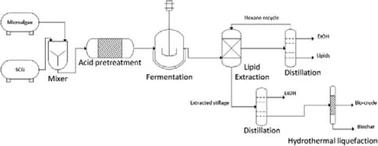当前位置:
X-MOL 学术
›
Sustain. Energy Fuels
›
论文详情
Our official English website, www.x-mol.net, welcomes your
feedback! (Note: you will need to create a separate account there.)
An alternative biorefinery approach to address microalgal seasonality: blending with spent coffee grounds
Sustainable Energy & Fuels ( IF 5.0 ) Pub Date : 2020-05-29 , DOI: 10.1039/d0se00164c Andre Prates Pereira 1, 2, 3, 4 , Tao Dong 5, 6, 7, 8 , Eric P. Knoshaug 5, 6, 7, 8 , Nick Nagle 5, 6, 7, 8 , Ryan Spiller 5, 6, 7, 8 , Bonnie Panczak 5, 6, 7, 8 , Christopher J. Chuck 1, 2, 3, 4 , Philip T. Pienkos 5, 6, 7, 8
Sustainable Energy & Fuels ( IF 5.0 ) Pub Date : 2020-05-29 , DOI: 10.1039/d0se00164c Andre Prates Pereira 1, 2, 3, 4 , Tao Dong 5, 6, 7, 8 , Eric P. Knoshaug 5, 6, 7, 8 , Nick Nagle 5, 6, 7, 8 , Ryan Spiller 5, 6, 7, 8 , Bonnie Panczak 5, 6, 7, 8 , Christopher J. Chuck 1, 2, 3, 4 , Philip T. Pienkos 5, 6, 7, 8
Affiliation

|
An effective method for the production of fuels and chemicals from microalgae is to ferment the carbohydrate fraction, extract the lipids and convert the resulting solids through hydrothermal liquefaction (HTL). In this process, known as Combined Algal Processing (CAP), multiple fuel precursors are produced effectively. However, one of the key challenges associated with a microalgae-based biorefinery is the reduced productivity of algae in the colder seasons. In this investigation, the potential for spent coffee grounds (SCG), a potentially valuable waste stream, to be blended with biomass from the microalgae Scenedesmus acutus (HCSD) to make up for the productivity shortfalls in periods of lower microalgae productivity to maximize the capacity for downstream equipment throughout the year was evaluated. Two different blend ratios were compared to only microalgae biomass or SCG, one representing winter season (40% microalgae and 60% SCG – blend 1) and another representing autumn and early spring (60% microalgae and 40% SCG – blend 2). Pretreatment of the blends showed higher monosaccharide release yields compared to microalgae alone, with an increase in mannose and galactose specifically. In the fermentation of the pretreated slurries, all the monosaccharides were consumed, resulting in ethanol titers of up to 23 g L−1 for the SCG blend, compared to 14 g L−1 ethanol for the algae alone. The lipid extraction from the blends resulted in yields of 95.5–99.7% (which translates to 173.8–193.5 kg per tonne of dry biomass processed in this biorefinery scenario) compared to 92.2% in HCSD (216.2 kg per tonne of dry biomass) and 68.1% in SCG (90.8 kg per tonne of dry biomass) alone. The residual solids left after fermentation and lipid extraction were converted via hydrothermal liquefaction (HTL) to produce bio-crude. The bio-crude yield was higher for microalgae (24.6%) than for the two blend cases (blend 1–17.5% and blend 2–19.7%). Theoretical energy calculations showed that the addition of SCG gave similar yields of fuel (gallon of gasoline equivalents) from the blends when compared to microalgae alone (94.7–96.5% depending on the blend of SCG). This work demonstrates that SCG can be easily incorporated with microalgae into a combined processing methodology and can therefore be used effectively during periods of lower availability of microalgae maintaining maximum operating levels of the conversion process equipment year-round. Moreover, co-processing algae with SCG not only leads to increased ethanol titers in the fermentation but also improves the lipid extraction yields.
中文翻译:

解决微藻季节性问题的另一种生物精炼方法:与废咖啡渣混合
从微藻生产燃料和化学品的有效方法是发酵碳水化合物部分,提取脂质并通过水热液化(HTL)转化生成的固体。在称为联合藻类加工(CAP)的过程中,可以有效地生产多种燃料前体。然而,与基于微藻的生物精炼厂相关的主要挑战之一是在较冷的季节藻类的生产力降低。在这项调查中,可能会将废咖啡渣(SCG)(一种潜在的有价值的废物流)与微藻场景生物的混合生物质混合的可能性。(HCSD),以弥补微藻生产率较低期间的生产率不足,从而使全年下游设备的能力最大化。将两种不同的混合比例与仅微藻生物质或SCG进行了比较,一种代表冬季(40%的微藻和60%SCG –混合1),另一种代表秋季和初春(60%的微藻和40%SCG –混合2)。与单独的微藻相比,共混物的预处理显示出更高的单糖释放量,其中甘露糖和半乳糖的含量增加。在预处理浆液的发酵中,所有单糖都被消耗了,导致SCG共混物的乙醇滴度高达23 g L -1,而14 g L -1乙醇仅用于藻类。从共混物中提取脂质的产量为95.5–97.7%(在此生物精炼方案中,每吨干生物质处理的产量为173.8–193.5千克),而HCSD(每吨干生物质216.2千克)的为92.2%。仅SCG中的百分比(每吨干生物质90.8千克)。发酵和脂质提取后残留的残留固体通过水热液化(HTL)产生生物原油。微藻的生物粗品产量(24.6%)高于两种混合情况(混合1–17.5%和混合2–19.7%)。理论能量计算表明,与单独的微藻相比,添加SCG可以从混合物中获得相似的燃料产量(每加仑汽油当量)(94.7-96.5%取决于SCG的混合物)。这项工作表明,SCG可以轻松地与微藻合并到组合处理方法中,因此可以在微藻可用性较低的时期内有效使用,从而保持全年转换工艺设备的最大运行水平。此外,藻类与SCG的共处理不仅导致发酵中乙醇滴度的提高,而且还提高了脂质的提取率。
更新日期:2020-06-30
中文翻译:

解决微藻季节性问题的另一种生物精炼方法:与废咖啡渣混合
从微藻生产燃料和化学品的有效方法是发酵碳水化合物部分,提取脂质并通过水热液化(HTL)转化生成的固体。在称为联合藻类加工(CAP)的过程中,可以有效地生产多种燃料前体。然而,与基于微藻的生物精炼厂相关的主要挑战之一是在较冷的季节藻类的生产力降低。在这项调查中,可能会将废咖啡渣(SCG)(一种潜在的有价值的废物流)与微藻场景生物的混合生物质混合的可能性。(HCSD),以弥补微藻生产率较低期间的生产率不足,从而使全年下游设备的能力最大化。将两种不同的混合比例与仅微藻生物质或SCG进行了比较,一种代表冬季(40%的微藻和60%SCG –混合1),另一种代表秋季和初春(60%的微藻和40%SCG –混合2)。与单独的微藻相比,共混物的预处理显示出更高的单糖释放量,其中甘露糖和半乳糖的含量增加。在预处理浆液的发酵中,所有单糖都被消耗了,导致SCG共混物的乙醇滴度高达23 g L -1,而14 g L -1乙醇仅用于藻类。从共混物中提取脂质的产量为95.5–97.7%(在此生物精炼方案中,每吨干生物质处理的产量为173.8–193.5千克),而HCSD(每吨干生物质216.2千克)的为92.2%。仅SCG中的百分比(每吨干生物质90.8千克)。发酵和脂质提取后残留的残留固体通过水热液化(HTL)产生生物原油。微藻的生物粗品产量(24.6%)高于两种混合情况(混合1–17.5%和混合2–19.7%)。理论能量计算表明,与单独的微藻相比,添加SCG可以从混合物中获得相似的燃料产量(每加仑汽油当量)(94.7-96.5%取决于SCG的混合物)。这项工作表明,SCG可以轻松地与微藻合并到组合处理方法中,因此可以在微藻可用性较低的时期内有效使用,从而保持全年转换工艺设备的最大运行水平。此外,藻类与SCG的共处理不仅导致发酵中乙醇滴度的提高,而且还提高了脂质的提取率。











































 京公网安备 11010802027423号
京公网安备 11010802027423号